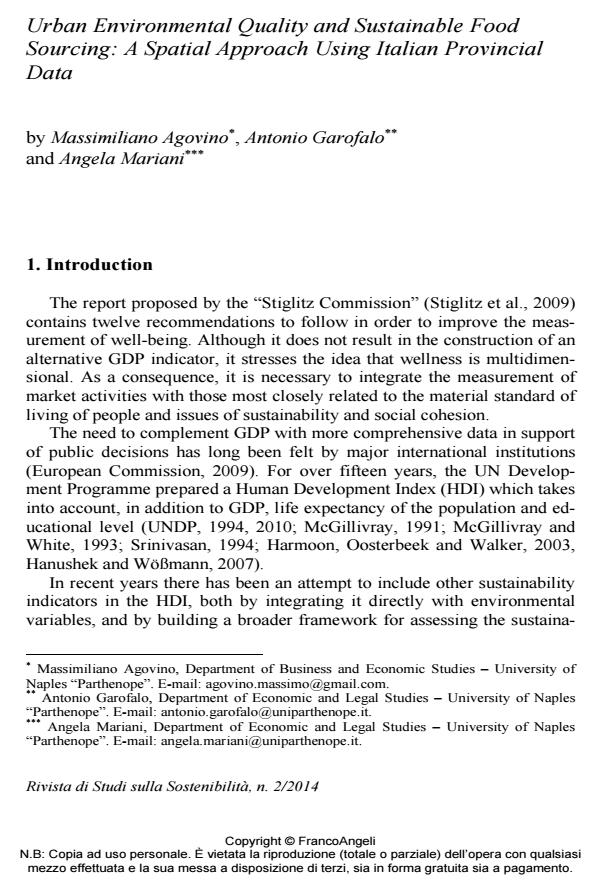Urban Environmental Quality and Sustainable Food Sourcing: A Spatial Approach Using Italian Provincial Data
Journal title RIVISTA DI STUDI SULLA SOSTENIBILITA'
Author/s Massimiliano Agovino, Antonio Garofalo, Angela Mariani
Publishing Year 2014 Issue 2014/2
Language English Pages 19 P. 139-157 File size 285 KB
DOI 10.3280/RISS2014-002009
DOI is like a bar code for intellectual property: to have more infomation
click here
Below, you can see the article first page
If you want to buy this article in PDF format, you can do it, following the instructions to buy download credits

FrancoAngeli is member of Publishers International Linking Association, Inc (PILA), a not-for-profit association which run the CrossRef service enabling links to and from online scholarly content.
Environmental pollution affects human health and well-being, not only directly, but also indirectly due to its effects on food safety and urban and peri-urban agriculture. Proper indicators of urban environmental quality could improve the measurement of the health and well-being component of the Human Development Index. In this paper, by using the Legambiente Index and the Local Moran Transition Probability Matrix, we assess and compare the performance of Italian provinces’ in providing urban environmental quality. Results show a persistent dualism between Northern and Southern Italy and the absence of positive environmental spillover among neighboring provinces. In Southern Italy, policymakers should focus more on improving sustainable food sourcing for a more sustainable and resilient urban development.
Keywords: Environmental quality, local moran transition probability matrix, spatial statistics, Legambiente Index, spatial diffusion; Exploratory Spatial Data Analysis (ESDA)
- Estimating urban food waste at the local level: are good practices in food consumption persistent? Massimiliano Cerciello, Massimiliano Agovino, Antonio Garofalo, in Economia Politica /2019 pp.863
DOI: 10.1007/s40888-017-0089-8 - The role of cultural consumption in reducing social exclusion: empirical evidence from Italy in a spatial framework Aniello Ferraro, Massimiliano Cerciello, Massimiliano Agovino, Antonio Garofalo, in Economia Politica /2019 pp.139
DOI: 10.1007/s40888-019-00144-w - Cancer mortality rates and spillover effects among different areas: A case study in Campania (southern Italy) Massimiliano Agovino, Maria Carmela Aprile, Antonio Garofalo, Angela Mariani, in Social Science & Medicine /2018 pp.67
DOI: 10.1016/j.socscimed.2018.03.027
Massimiliano Agovino, Antonio Garofalo, Angela Mariani, Urban Environmental Quality and Sustainable Food Sourcing: A Spatial Approach Using Italian Provincial Data in "RIVISTA DI STUDI SULLA SOSTENIBILITA'" 2/2014, pp 139-157, DOI: 10.3280/RISS2014-002009